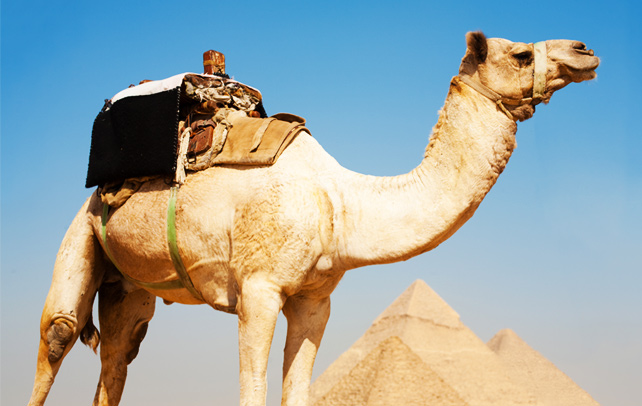Amazing Facts About Camels

The term Camel is a form of Arabic language which has been derived from the triconsonantal root signifying ‘beauty’. Camels are domestic animals found in dry and desert areas of Northern Africa and Asia. It is known as ‘the ship of the desert’ because it can move smoothly across the sand of desert just like a ship that glides across the waters. There are two species of camel: Dromedary (Camelus dromedarius) and the Bactrian (Camelus Bactrianus). Camels are among those few animals that can survive in a desert area where there is always a scarcity of water. They drink 20 to 40 gallons of water in one go. Camels can live without water for a number of days. This ability of camels to withstand for long periods without water is due to various physiological factors; such as, oval shaped red blood cells, adaptation to body temperature, nostrils, its thick coat to save from sunlight, and many more.
Fast Facts
Scientific Name: One-humped: Camelus dromedarius
Two-humped: Camelus bactrianus
Kingdom: Animalia
Phylum: Chordata
Subphylum: Vertebrata
Class: Mammalia
Order: Artiodactyla
Family: Camelidae
Genus: Camelus
Species: Camelus Bactrianous and Camelus Dromedarius
Origin: North America
Diet: Herbivorous (thorny plants, dry grasses, saltbush)
Height: One-humped: 5.8 to 7.5 feet
Two-humped: 6 to 7.6 feet
Length: One-humped: 9.6 to 11 feet
Two-humped: 10 to 12 feet
Weight: One humped: 320 to 680 kg
Two-humped: 590 to 950 kg
Natural Habitat: Deserts (hot climate)
Number of Teeth: 34
Lifespan: 40 to 50 years
Age of Maturity (females): 3 years
Age of Maturity (males): 6 years
Gestation Period: 406 days (around 13 – 14 months)
Number of Offspring: 8
Amazing Facts About Camels
- Camels do not store water in humps. Humps actually act as a pool of fatty tissues. This fat is used by the camel in case it faces scarcity of food. With continuous use the hump droops down, but it regains its original size with proper food and rest.
- The shape of red blood cell in camel’s body is oval and this is the reason why they can go long periods without water. Camel is the only mammal to have oval red blood cells.
- Camels can drink up to 20 to 40 gallons of water in one go and it helps them to protect themselves from scorching heat.
- The body temperature of camels ranges from 34 degrees at night to 41 degrees during the day. This is the reason why they can bear high temperatures. They don’t begin to sweat until they are over 41 degrees.
- Camels cannot graze without splitting their lips as splitting help them to graze.
- Camel is very good at eating thorny twigs because it can eat them without injuring its mouth.
- Camels can kick in all four directions with each of their four legs.
- When required, camels can close their nostrils against wind and sand. The shape of their nostrils allows them to retain water vapour and return it to the body as fluid. It is one of those features that help a camel survive without water for several days.
- Most of the mammals lose 15% of their body fluid whereas camels lose 25% of their body fluids without getting dehydrated.
- Being the ruminants of cows and goats, the female camel is called as cow, the male camel is called as bull, and a baby camel is called as calf.
- Consumption of green plants helps a camel in attaining moisture in the body.
- Camel’s skin functions as a thick coat that reflects sunlight and insulates it from the desert heat.
- In defence, camels spit a green and foul smelling fluid from their stomach all over you when provoked or annoyed.
- Camel’s milk is rich in fat and proteins when compared to cow’s milk. Moreover, the procedure for converting camel’s milk into butter is not the same as cow’s milk. It readily converts into yogurt.
- Camels are blessed with three eyelids to protect their eyes from blowing sand.









